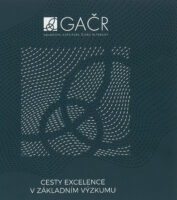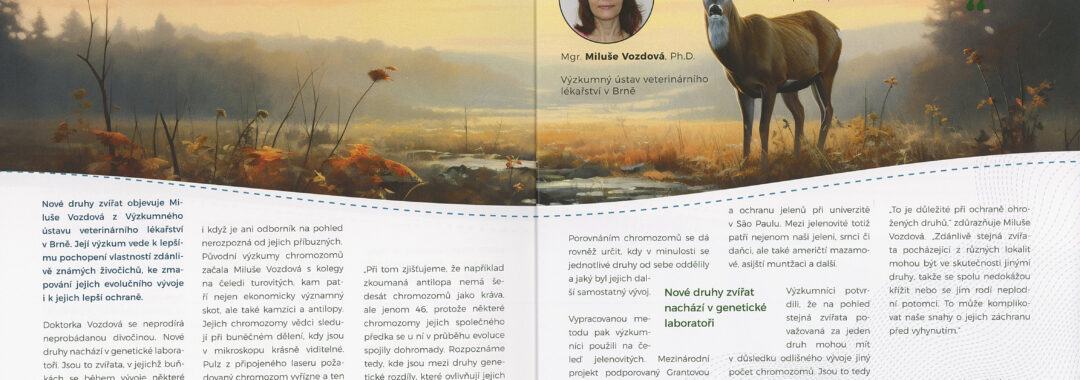 The Czech Science Foundation (GACR) this year celebrates its 30th anniversary of funding scientific projects. Throughout its existence, it has funded over 20,000 basic research projects, totalling more than CZK 71 billion. On this occasion, it issued a publication entitled ‘The Path of Excellence in Basic Research’ which provides information on projects selected by different professional committees of the GACR and recognised as excellent in terms of achieved results.
The Czech Science Foundation (GACR) this year celebrates its 30th anniversary of funding scientific projects. Throughout its existence, it has funded over 20,000 basic research projects, totalling more than CZK 71 billion. On this occasion, it issued a publication entitled ‘The Path of Excellence in Basic Research’ which provides information on projects selected by different professional committees of the GACR and recognised as excellent in terms of achieved results.
One of the contributions is associated with the international project titled: ‘The use of molecular cytogenetics for evolutionary and taxonomic studies in Cervidae’, with the principal investigator Mgr. Miluše Vozdová, Ph.D. from the VRI.
Miluše Vozdová graduated in molecular biology and genetics at the Faculty of Science, Masaryk University in Brno, where she also completed postgraduate studies in genetics. Since 1995, she has been working at the Veterinary Research Institute as a member of the significant research group Animal Genetics and Cytogenetics focused on comparative cytogenetics and reproductive genetics. She is involved in scientific research aimed at molecular cytogenetic and genetic analysis of somatic cells, gametes and embryos. She deals mainly with comparative animal cytogenetics, specifically concentrating on the chromosome evolution in mammals. She also investigates genetic and epigenetic changes in cancer cells, male meiosis, sperm quality, and genetic disorders of gametes in animals and humans. She implemented a number of projects supported by the Czech Science Foundation and the Internal Grant Agency of the Ministry of Health of the Czech Republic, and participated in projects investigating the impact of occupational exposure and air pollution on human health and reproduction.
How did you become involved in this subject, and what aspects personally captivate or engage you the most?
In our laboratory, we have long been involved in comparative cytogenetics and chromosome evolution in mammals and I believe we have a strong reputation in this field globally. We have been working on a project focusing on chromosome changes and evolutionary relationships within the Bovidae family, taking the next step to examine the closely related artiodactyl group, the Cervidae. Through our collaboration with many zoological gardens, we have a continuously growing collection of biological material from exotic captive species. However, due to stringent measures regarding the export of live animals from most Latin American countries, there are no representatives of South American deer kept on the European continent, and their biological material is not available for research. When the opportunity arose to collaborate with a partner from Brazil, we seized the chance without hesitation. The shared project provided us with the opportunity to investigate animals indigenous to the Amazonia and neighbouring areas, species that are still shrouded in mystery, not only for us Europeans. Even though we could not see any of the studied deer alive, and only received fixed material, I remain fascinated by what we uncovered about their relationships and evolution throughout the two year-project. I am proud that we could contribute to improving their protection through the outcomes we have achieved.
Who was the international partner with whom you collaborated on implementing this project?
This international project was co-funded by the Czech Science Foundation and the Brazilian FAPESP. The project was carried out in collaboration with the Deer Research and Conservation Center (Nucleo de Pesquisação e Conservação de Cervídeos, NUPECCE) at São Paulo State University (Universidade Estadual Paulista, UNESP). The Brazilian organisation NUPECCE specializes in the capture and sampling of wild deer as well as their captive breeding. They maintain a collection of tissue cultures and conduct measurements and experiments aimed at the biology of these animals. The investigator of the Brazilian part of the project was Prof. José Maurício Barbanti Duarte, Ph.D., Head of NUPECCE, a member of the Deer Specialist Group of the International Union for Conservation of Nature (IUCN) and coordinator of several conservation and endangered species programmes in Brazil.
How did the collaboration take place?
As part of the collaboration, our department hosted multiple internships for masters and postgraduate students from São Paulo State University. We conducted research together in our laboratory on the material provided to examine the chromosomal variations among South American deer and to establish their relationships at the levels of species, subspecies, and cytotypes. We also focused on analysing sperm chromosomes and examining how the reproduction of animals with different chromosomes is affected by crossbreeding.
Which findings from the project do you consider particularly important for society?
Most importantly, we have shown that the current systematic classification of these deer, primarily relying on their appearance or the measurement of skeletal remains, does not correspond to reality. It turns out that animals that seem identical, or very similar, actually belong to entirely different species. This must be taken into account in relation to their conservation and captive breeding. It is essential to avoid the crossbreeding of animals originating from different geographic locations and, most importantly, to reassess the abundance of individual natural populations. This might result in the inclusion of some groups on the IUCN Red List of Threatened Species.
The VRI was involved in projects supported by GACR at the very beginning of the existence of the agency. In 1993, the VRI was co-investigator of the project GA511/93/2367 ‘Indication, identification, characterization and assessment of risks of anomalous organic contamination of the rock environment in the Czech Republic (1993-1995, GA0/GA)’, with a budget of 400 thousand CZK. Since then, the VRI has been the principal investigator or co-investigator in another 106 projects funded by GACR.
Ildikó Csölle Putzová
Head of CTT PS, VRI


